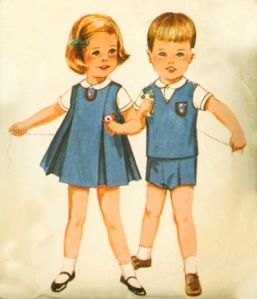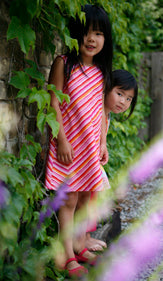Toronto couple Kathy Witterick and David Stocker became international news a few weeks ago when they made public their decision to raise their third child, now four months old, without imposing a specific gender identity, and to keep the child’s sex a secret. The couple explained that they wanted to neutralize the way their child would be treated, and to create an environment in which little Storm could grow freely and make independent decisions. The public response illustrated clearly how strong our feelings are on this subject of gender identity and childrearing.
 I think about gender stereotyping quite a bit, particularly its philosophical and practical application to the design of children’s clothing. Many parents I know have strong feelings about the way children are gender-directed from birth, through their clothing, toys and entertainment, but the vast majority of us participate in this process. Even if we feel the urge to ban the Barbie movies from our homes and encourage our sons to wear whatever they like, no matter how unusual, most of us take the easier road to mainstream social acceptance.
I think about gender stereotyping quite a bit, particularly its philosophical and practical application to the design of children’s clothing. Many parents I know have strong feelings about the way children are gender-directed from birth, through their clothing, toys and entertainment, but the vast majority of us participate in this process. Even if we feel the urge to ban the Barbie movies from our homes and encourage our sons to wear whatever they like, no matter how unusual, most of us take the easier road to mainstream social acceptance.
I wanted to share a photo with you of an adorable little boy, a toddler, playing outside on a beautiful summer day in a pink romper, bloomers and bonnet. But the subject of said photograph, my otherwise-enlightened husband, refused to grant me permission to publish it. Perhaps that speaks louder than the image itself. The photo struck me as an excellent illustration of how much less uptight North American parents were in the days of gender-neutral rompers and playsuits, the clothing of my 1970s “Free to Be…. You and Me” childhood. I wondered: as we’ve grown more egalitarian, have we also become more uptight about the way we dress our children?
My customers frequently express disappointment to me at the lack of variety available in mainstream boys’ clothing, and its very limited colour palette, as well as the preponderance of pink and purple and preciousness in girls’ clothing. But I have learned from my years of designing and selling children’s clothing, that colour remains a very touchy subject for many parents, and that we tend to impose our choices on our children, whether consciously or not. I’ve also noticed that children shopping with me tend to be attracted to vibrant and unusual colours, regardless of their sex.
It’s more than simply colour influencing our judgment; the cut of a garment sends subtle messages about gender appropriateness as well. Is a white t-shirt with tiny scalloped trim around the neck gender neutral? What about jeans with a subtle flare, or a top with cap sleeves? Even within the basic realm of t-shirts and pants, there truly is very little unisex clothing available in mainstream stores. Have we lost our taste for it? I would love to take on the challenge of designing a completely gender-neutral season. But would it sell?
At the One of a Kind Show last Christmas, I overheard one of my customers telling a friend that her kindergarten-aged son proudly wore tights to school. When I asked if he’d encountered any harassment, she told me that when a classmate said to him “Why are you wearing tights? Girls wear tights!” her son retorted “Superheroes wear tights!” and he has never been teased since. Good for him, and good for her.
I wonder what schoolyards would look like if we were all relaxed enough to let our children make their own choices about clothing. Would more boys, like Storm’s 5-year-old brother Jazz, choose to wear pink dresses? Reporting on this unusual family, the Toronto Star printed an excerpt from Jazz’s journal in which he wrote “Help girls do boy things. Help boys do girl things. Let your kid be whoever they are!”
Devorah Miller
Red Thread Design

